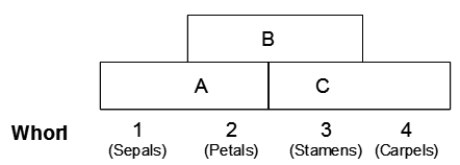Use the following to answer questions
The diagram below illustrates the normal expression of three different groups of genes (A, B, and C) within four different whorls of a developing flower. Normally, whorl 1 produces sepals, whorl 2 produces petals, whorl 3 produces stamens, and whorl 4 produces carpels. Furthermore, expression of class A genes inhibits class C genes, and expression of class C inhibits class A. 
-What kind of mutation would produce carpels in whorls 1 and 4 and stamens in whorls 2 and 3?
Definitions:
Conditioned Stimulus
A previously neutral stimulus that, after being paired with an unconditioned stimulus, elicits a conditioned response.
Unconditioned Stimulus
In classical conditioning, a stimulus that unconditionally—naturally and automatically—triggers a response without prior conditioning.
Unconditioned Response
In classical conditioning, the automatic and natural reaction elicited by the unconditioned stimulus.
Neutral Stimulus
A neutral stimulus is a stimulus that initially produces no specific response other than focusing attention, until it is paired with an unconditioned stimulus.
Q5: Which of the following genes are paralogs?
Q33: Round seeds (R) are dominant to wrinkled
Q34: Do the principles discovered by Mendel for
Q38: Which of the following are NOT prokaryotes?<br>A)
Q39: Genetic diseases in humans are usually rare
Q44: Proteins that affect the structure of DNA
Q46: The attachment point on the chromosome for
Q60: Which of the following enzyme activities play
Q62: In peas, tall (T) is dominant to
Q62: Phylogenies can be used to reconstruct the